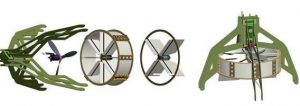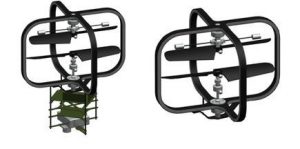Mechanics
The operational scenarios which characterize aerial service robotics suggest the employment of aerial platforms with a high level of manoeuvrability together with the ability to safely interact with the human world, including both infrastructures and humans, without the risk of damages or accidental crashes.
Among existing airframes, such as for example helicopters and airplanes, rotorcraft systems with shrouded propellers appear as the ideal platform for robotic applications due to their high manoeuvrability, the ability of flying at a very low speed or even to maintain a certain constant position (i.e. hovering), and the intrinsic safety deriving from the shroud.
Two different mechanical configurations, the ducted-fan and the coaxial rotor, will be developed throughout the project according to previous experiences of University of Bologna and ETH-Zurich:
Ducted-Fan
The mechanical layout of a ducted-fan aircraft is essentially characterized by three main subsystems (see figure, source Aslatech srl, www.aslatech.com).

The first one is represented by a fixed-pitch rotor connected to a (electric or endothermic) motor. This subsystem has the fundamental role of generating the main thrust which is necessary to actuate the overall dynamics and counteract for the gravity force. The second subsystem is composed by a set of actuated flaps, namely profiled moving surfaces, which are positioned below the propeller in order to properly deviate its air flow. The flaps are governed to achieve full controllability of the attitude of the vehicle, playing the role that the tail rotor and the cyclic pitches have in classical helicopters. The third subsystem is given by the shroud and the fuselage which contains all the avionics and application-dependent hardware; the role of the shroud is to protect the environment and the humans from the propeller and, if suitably designed, to even improve the efficiency of the thrust generation increasing the flight endurance or the payload.
Coaxial Rotor
The design of a coaxial rotorcraft is usually governed by a coaxial rotor configuration with one fixed-pitch and one cyclic-pitch rotor driven by two motors (see figure, source skybotix technologies, www.skybotix.com).

Horizontal movement of the vehicle is realized using control over the main rotor’s cyclic-pitch, tilting the rotorcraft’s thrust vector in a desired direction. Using the vehicles differential drag moment between upper and lower rotor allows simple yaw control. Depending on the design, a stabilization bar or special rotor blades can be integrated into the rotor head to enhance the passive stability of the vehicle even more. Inherent passive attitude stability is one of the utmost notable attributes of this class of aircrafts. This allows the system to self stabilize even after collisions with an obstacle. If the airframe is designed accordingly, rotors can be shielded from the environment without significantly limiting the vehicles aerodynamic performance.
